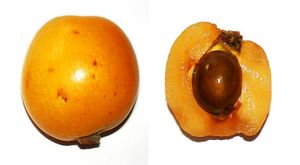Loquats

The loquat (Eriobotrya japonica) is a fruit tree in the subfamily Maloideae of the family Rosaceae, indigenous to southeastern China.
The leaves are alternate, simple, 10-25 cm long, dark green, tough and leathery in texture, with a serrated margin, and densely velvety-hairy below with thick yellow-brown pubescence; the young leaves are also densely pubescent above, but this soon rubs off.
Loquats are unusual among fruit trees in that the flowers appear in the autumn or early winter, and the fruits are ripe in late winter or early spring. In Northern California, loquats bear fruit in May, while in Southern California, loquats bear fruit in April. The flowers are 2 cm diameter, white, with five petals, and produced in stiff panicles of three to ten flowers. The flowers have a sweet, heady aroma that can be smelled from a distance.
Loquat fruits, growing in clusters, are oval, rounded or pear-shaped, 3-5 cm long, with a smooth or downy, yellow or orange, sometimes red-blushed skin. The succulent, tangy flesh is white, yellow or orange and sweet to subacid or acid, depending on the cultivar. Each fruit contains five ovules, of which one to five mature into large brown seeds. The skin, though thin, can be peeled off manually if the fruit is ripe.
The fruits are the sweetest when soft and yellow.
Use
The loquat is comparable with its distant relative, the apple, in many aspects, with a high sugar, acid and pectin content. It is eaten as a fresh fruit and mixes well with other fruits in fresh fruit salads or fruit cups. Firm, slightly immature fruits are best for making pies or tarts. The fruits are also commonly used to make jam, jelly, and chutney, and are delicious poached in light syrup.
A type of loquat syrup is used in Chinese medicine for soothing the throat like a cough drop. Combined with other ingredients and known as pipa gao (枇杷膏; pinyin: pípágāo; literally "loquat paste"), it acts as a demulcent and an expectorant, as well as to soothe the digestive and respiratory systems. Loquats can also be used to make an excellent light wine.
Like most related plants, the seeds (pips) and young leaves of the plant are slightly poisonous, containing small amounts of cyanogenetic glycocides which release cyanide when digested, though the low concentration and bitter flavour normally prevents enough being eaten to cause harm.
History
The Loquat is a fruit of Southeastern Chinese origin. It was introduced into Japan and became naturalised there in very early times, and has been cultivated there for over 1,000 years. It has also become naturalised in India and many other areas. Chinese immigrants are presumed to have carried the loquat to Hawaii.
Eaten in quantity, loquats have a noticeable but gentle sedative effect, with effects lasting up to 24 hours.

Nísperos Callosa d'En Sarriá
Loquats arrived in Spain through the merchant seamen who came to the east coast. They are known as nísperos and those from Callosa d'En Sarrià have a characteristic yellow or slightly orange colour, a sweet or slightly acid flavour and a yellowish or whitish pulp. They have a shiny, compact texture and a tough skin.
Those grown in the comarca of Baixa Marina have been protected by Denominación de Origen Protegida of Callosa d'En Sarrià. They can be bought fresh or preserved, either in syrup or jams, juices and liqueurs. They may also be used to garnish meat, and can form a part of sweet dishes and ice-cream.
They are in season from the beginning of April to the end of June.
Find recipes that contain 'Loquats'
#loquats #fruit #pectin #wine #piesortarts #apple #pear #chutney